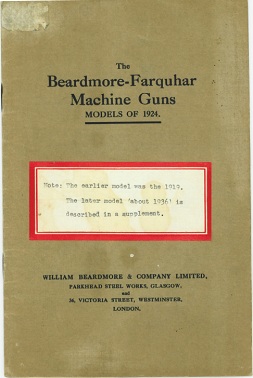The Beardmore-Farquhar was designed by Colonel Moubray Gore Farquhar in Birmingham, England, and manufactured by William Beardmore & Co, a firm also located in Birmingham. It had a number of interesting and unique features, but unfortunately Col Farquhar was in the position of marketing a new machine gun to the British military right after the end of the Great War. There were piles of Lewis guns already in service, and they had just concluded the War to End All Wars. Not a good time to be marketing fancy new munitions. The Beardmore-Farquhar did undergo some initial testing by the Royal Air Force, but it didn’t appear revolutionary enough to justify the expense (and probably no gun would have, short of something that could shoot down German fighters and brew your afternoon tea at the same time).
However, this official rejection is not necessarily indicative of poor performance by the gun. Among its neat features was a two-part recoil system – a gas port fed into a chamber to compress a recoil spring, which was released when compressed to a preset point and pushed the bolt rearwards, ejecting the empty cartridge. This was claimed to be a much smoother action than a directly operating gas piston, and thus be less likely to tear rims on the service .303 cartridges, as well as preventing damage or malfunctions from high gas pressures. When the bolt reached its rearward position, a second spring was released to load a new round from the magazine and close the bolt.
In what is certainly a direct shot at the Lewis, the Beardmore-Farquhar literature points out that the B-F drums and magazines are spring powered, and do not use an indexing mechanism driven by the gun action (and thus the potential cause of a malfunction). The Lewis drum, on the other hand, was susceptible to being damaged but was immune to springs breaking or taking a set.
The Beardmore-Farquhar was a light infantry machine gun or as an aerial observer’s gun was available in a variety of calibers, including .303, 7.65mm, and 7mm. A scaled-up version was also made in .50 caliber for Naval use.
Manuals
English (click to download in PDF format):


Hello
thoughly enjoyed this booklet as I have been collecting patents on this gun.
Previously I had only seen one photo and no data on the 0.5″ version.
Just noting that page 7 & 9 are missing from thid PDF
http://www.military.com/video/guns/machine-guns/beardmore-farquhar-machine-gun/2809173637001/
Here a video of it
Was the 0.5″ round the same as that used in the later Vickers water-cooled MGs used (for instance) as quadruple mounts by the Royal Navy and in some light tanks and armoured cars? The round seems to have been ‘underpowered’. Certainly there was an attempt to replace it with a BESA version of the Czech 15mm air-cooled ‘heavy’, and an attempt to use the 20mm Oerlikon round in the latter. In the end, they used either the Oerlikon or the (simplified) Polsten, and were successful.
I don’t know for sure – the manual doesn’t specify which .50 – but I would suspect that it was the British 12.7×81.